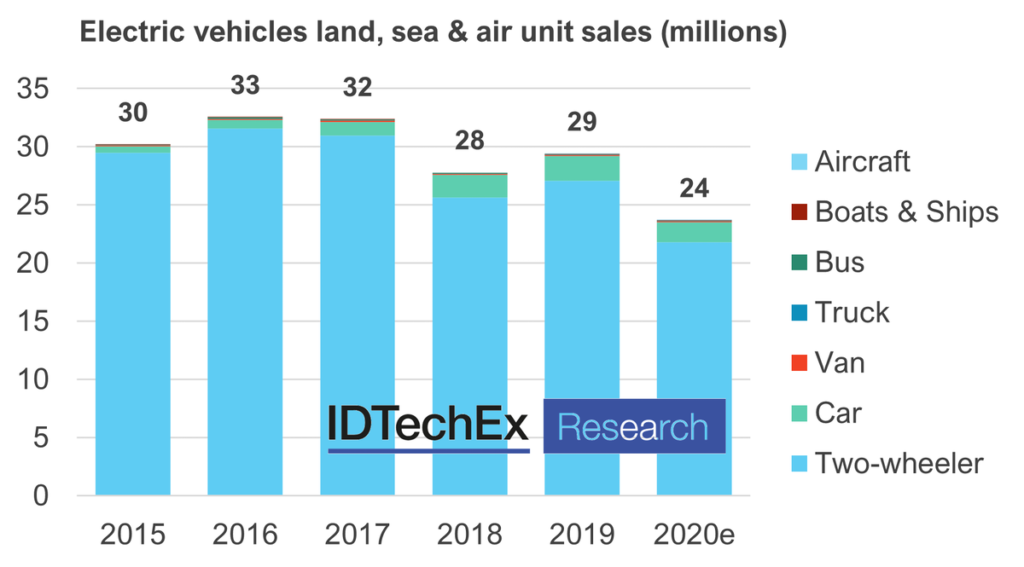A new report by IDTechEx forecasts that the electric vehicle market will continue to grow in the next two decades, particularly taking into consideration that, despite the covid-19 pandemic, sales of high-voltage hybrids, plug-in hybrids, and battery-electric vehicles all saw an increase in most regions across the globe.
Putting Europe as an example, IDTechEx points out that in 2020, sales of petrol, diesel and other alternatively powered vehicles jointly dropped by 24%, but high-voltage hybrids were up 54%, battery-electric vehicles were up 107%, and plug-in hybrids were up 211%.
Despite positive numbers in the US and Europe, the market analyst says it is important to pay attention to what’s going on in Asia, where the dominant form of transportation is the motorcycle.
“In the past decade, India has overtaken China to become the world's largest motorcycle market, selling roughly 17 million in fiscal year 2020 (SIAM) in a global market of 57 million (Marklines),” the report states. “It is no coincidence that India has seven out of the world's top ten most polluting cities. When we hear ambitious electrification targets from countries like India, it is the electrification of two-wheelers and micro-mobility, not cars, which is the focus.”
By 2041, however, the market analyst sees the electric car dominating both unit sales and battery demand, as they have become the focus of automotive startups, particularly in China, with plug-ins increasingly losing share.

When it comes to electric vans or light commercial vehicles, IDTechEx believes that the next few years will see companies conducting large pilot projects to establish that eLCVs meet their operational range, load capacity, payload and reliability requirements.
In the analyst’s view, as experience and trust in electric technology grows, widespread replacement of ageing diesel LCVs with eLCVs will begin. This electrification may be also driven by increasing demand for freight delivery as the retail industry grows its online sales platforms, and consumers gradually abandon private car ownership for mobility-as-a-service platforms.
Similarly, sales of electric buses are expected to grow but not necessarily in its biggest market, China, but rather in Europe and Southeast Asia.
“The days of the fossil fuel powered combustion engine are numbered,” the document states in the segment dedicated to electric trucks.
According to the Cambridge-based firm, government pressure to lower emissions is likely to drive heavy vehicle manufacturers to zero on-road exhaust emission powertrain solutions.
The transition to electric power in the marine sector may not be so smooth - according to IDTechEx - due to the sheer scale of the power, energy and distance requirements for many vessels.
For the analyst, what is likely to happen in the next two decades is that solutions such as batteries and fuel cells to premium fuels, scrubbers and slow-steaming are to become the way of exiting polluting fossil fuels.
“Today, batteries have mainly emerged in leisure boating, ferries and short-sea vessels, where they have enjoyed steady uptake due to small vessel sizes or well-defined cyclical routes (that allow for opportunity charging),” the review states. “In larger deep-sea vessels, uptake is slow, but unprecedented global emissions regulations are driving change, and shortages of traditional solutions on the horizon are creating new opportunities for energy storage start-ups in the arena.”
Finally, in the electric aerospace realm, the prediction is that, given that small fixed-wing pure-electric is trading now, larger hybrid and pure-electric aircraft up to regional aircraft will be available within ten years.
“The wild card is vertical-takeoff pure-electric aircraft as air taxis (eVTOL) and personal aircraft,” the report states.
This story originally appeared on MINING.COM.
Comments